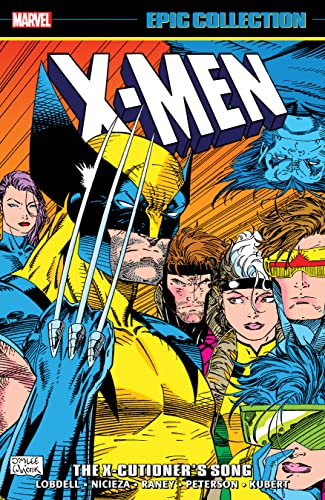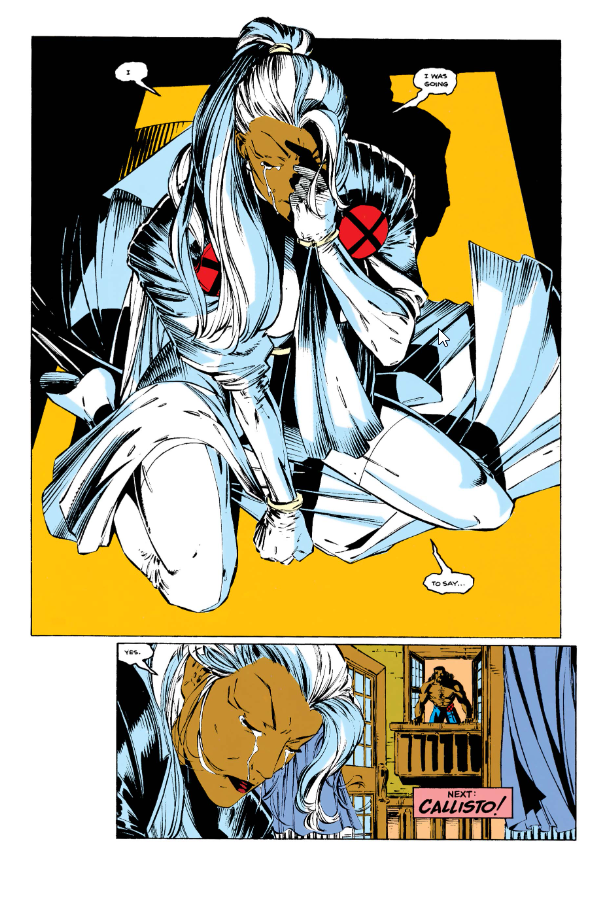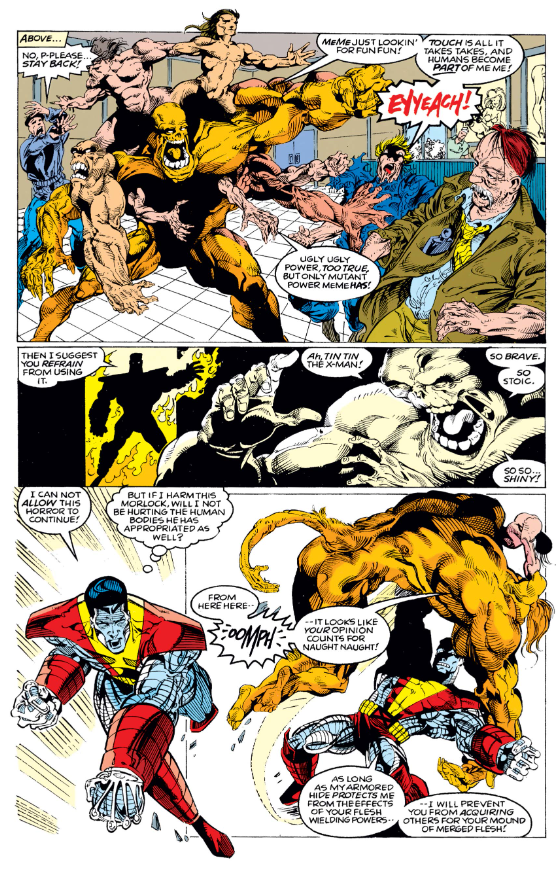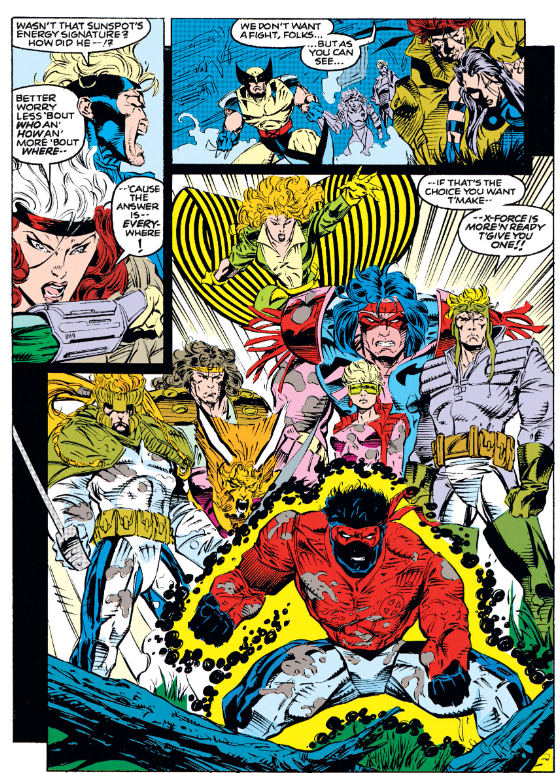X-Men Epic Collection: X-Cutioner’s Song features the collective X-Men titles at arguably their most tumultuous time. Less than a year before the earliest issues collected in this volume were published, the X-Men were at the height of their powers, coming out of a successful linewide relaunch led by superstar artists which propelled the books to record-breaking sales. Yet less than halfway through this volume, those creators are gone, left to start a new comic book company in what is sometimes called the “Image Exodus.” A new batch of creators, most untested in such a bright spotlight, were then forced to learn on the job while picking up the pieces left behind by the exodus, while also somehow crafting those pieces into the next semi-annual crossover event story to bring all the various X-Men titles together to tell one cohesive story.

That they not only succeeded but, in the process, crafted one of the better X-Men crossovers of all time, was never guaranteed. But a combination of talent and the lift that came from working with some of the most popular characters in all of comics ultimately won out. Before “X-Cutioner’s Song,” there was a legitimate question as to whether the X-Men were popular because people liked the characters, or if they were popular because creators like writer Chris Claremont and artist Jim Lee were crafting their stories. The Image Exodus offered an opportunity to answer that question,
While the record breaking sales of X-Men (vol. 2) #1 would never be met again, the post-Image Exodus X-books, buoyed by a popular cartoon and accompanying action figure line, continued to dominate the comic book marketplace, becoming a key source of revenue for Marvel even as the speculator bubble of the early 90s burst and corporate chicanery led to things like layoffs and bankruptcy. Thus, X-Men Epic Collection: X-Cutioner’s Song captures the point in time in which the question of whether or not the X-Men could not only survive but thrive without the likes of Lee and Claremont is both raised and answered. It captures the point in time in which the X-Men become self-sustaining, when it is made clear that people love their stories regardless of who was crafting those stories.
Looming Exodus
The first third of X-Men Epic Collection: X-Cutioner’s Song represents the last gasp of the ’91 relaunch and whatever ideas artists Jim Lee and Whilce Portacio (working with scripter Scott Lobdell) had brought to the books when they were handed complete control. If these stories feel a little warmed over, like their chroniclers had perhaps moved on to more enticing things, well, that was likely the case.
Though one of his more famous images adorns the cover of this collection, Jim Lee only draws two issues contained therein, X-Men (vol. 2) #10-11. Those issues present the long-teased Longshot/Dazzler/Mojo story Lee had presumably been planning since the start of his run, referenced as it was in the “coming soon!” pinup that adorned one of the X-Men (vol. 2) #1 variants and teased via subplot pages in the earlier Omega Red story. It’s hard to believe that what we get in this story is what Lee intended, as the whole thing is a relatively slapdash affair that sees Mojo II (a character who appeared briefly in an annual, and on a trading card) team-up with the X-Men to usurp Mojo, a relatively major shakeup of this little corner of the X-universe that is treated mostly as an afterthought. It doesn’t help that with Lee presumably busy getting WildC.A.Ts ready to launch for Image, both issues feature a shorter main story drawn by Lee, with a backup story by a different artist (starring Maverick, the hot character find of 1991 whom Lee introduced in the previous volume and never really took off as a character). Scott Lobdell, had been scripting Lee and Portacio’s plots after John Byrne bailed, is the sole credited writer of X-Men #11; presumably, he’s executing Lee’s vision of the story’s conclusion, but technically, Lee doesn’t even finish plotting his final story.
Whilce Portacio’s run as penciller/plotter on Uncanny X-Men ends with a similar whimper, albeit more of a character-driven one. His final issues, Uncanny X-Men #289-290, are pure soap opera. Quiet issues with minimal action (a brief fight involving Iceman and the cybernetic ninjas Portacio introduced in his earlier X-Factor run aside), Portacio goes out focusing on character drama, as Iceman introduces his non-white girlfriend to his bigoted father, Archangel angsts about his metal wings, the newly-introduced Bishop struggles to fit it, and Forge proposes to Storm, only to inexplicably quit the team not because she says no, but because she doesn’t say yes fast enough.

In its way, it feels as much like a student turning in their homework on the last day before summer vacation as Lee’s Mojo/Longshot story (the escalation in the Forge/Storm relationship in particular comes out of nowhere; presumably, Portacio intended to build up to it over time and simply rushed the ending on his way out), but the focus on characterization lingers more than the bog-standard toothless media satire of the X-Men story. There’s also a mild charge in the juxtaposition of the kinetic energy of Portacio’s pencils with a plot that largely amounts to “people talking about their problems.”
Missing Image
Once Portacio and Lee handed in their final issues on their way to helping launch a brand new creator-driven comics publisher, Marvel and editor Bob Harras had to scramble to find replacement creators. Writer Scott Lobdell was a natural fit, having already been scripting both series, and was given full reign over Uncanny X-Men. Fabian Nicieza, who had served a similar scripting role making sense of Rob Liefeld’s plots over on X-Force before Liefeld also left for Image, was tapped to write X-Men. The search for new regular artists continued, with a pair of fill-in artists working on the immediate post-Image Exodus stories.
In X-Men #12-13 Nicieza kicks off his run with a two-part story exploring Professor Xavier’s past via the introduction of a new villain, Hazard. He is a contemporary of Xavier whose father worked alongside Xavier’s father (as well as Juggernaut’s father) in the past. He has wrist gauntlets that fire little wires that he uses his power to electrify, and has barely appeared in comics outside this introductory arc. Drawn by Art Thibert, Jim Lee’s inker earlier in the series, the whole story reads like a frighteningly-effective copy of what the book had been doing before Lee’s departure: Nicieza captures the book’s “tease a mystery-answer the mystery with another mystery” plotting style, while Thibert does his best to imitate Lee’s look. Squint, and you’d be forgiven for assuming Lee remained on the book (which is likely the effect Thibert was instructed to generate). X-Men will shortly begin to develop its post-Lee identity, but in issue #12 and #13, it’s simply treading water.
Over in Uncanny X-Men, Scott Lobdell is joined by penciler Tom Raney for a three-part story involving Colossus’ brother Mikhail and the Morlocks. It is largely a deck-clearing exercise of a story: Portacio had re-introduced Mikhail but done little with him; this story wipes him off the board, as well as the Morlocks, for a second time (they had previously been nearly eradicated during the famous “Mutant Massacre” crossover, then surged back). Lobdell also makes a point in the course of the story to put to rest Archangel’s troubled relationship with his wings and the transformation he underwent as a result of events kick-started by “Mutant Massacre.”
How much all this deck-clearing was Lobdell’s idea and how much came from Bob Harras, I do not know. But the Morlock story, while probably half an issue to an issue too long, is entertaining in spite of/in addition to the behind-the-scenes machinations. It features a rare field mission for Professor X and some fun Jean Grey/Archangel interactions (in which Jean essentially tells her old friend to get over himself). The Tom Raney art is also particularly well-suited to the story, as he turns in a coterie of grotesque Morlocks running amok in New York City. MeMe, the newly-introduced Morlock with the power to absorb other people into his person, remains a haunting image.

X-Cutioner’s Song
Ever since the aforementioned “Mutant Massacre” in 1986, the X-books had participated in a semi-annual crossover event. Prior to the launch of the titular “X-Cutioner’s Song” in this collection, the last such event had been 1990’s “X-Tinction Agenda” (in 1991, the summer crossover was passed over in favor of the linewide relaunch that introduced the second X-Men title and new creative teams across the books). As such, newly-christened writers Scott Lobdell and Fabian Niceiza not only had to keep the books running after their previous creative drivers left, but orchestrate an event uniting the four “main” X-books (including Nicieza’s X-Force and X-Factor, the series helmed by Peter David since the relaunch), bringing the casts of the four series together for the first time since 1990. That they pulled it off under the circumstances is impressive; that the result stands as one of the better X-Crossovers of all time is even more impressive.
“X-Cutioner’s Song” takes as its starting point plotlines introduced in Nicieza and Liefeld’s X-Force and the mystery surrounding the relationship between Cable, X-Force’s militant leader-from-the-future and his archenemy Stryfe, the armor clad villain who mysterious looks just like Cable (as well the mystery of the pair’s possible relationship to Cyclops and Jean Grey of the X-Men). The crossover opens with a banger of a hook, as Stryfe — posing as Cable — shoots Professor X at a Lila Cheney concert. This would-be assassination sets off a collective hunt for Cable and X-Force — the former New Mutants, one-time wards of the X-Men, who have cast their lot with Cable and his theoretically-more-aggressive-than-the-X-Men approach to fighting supervillains — by the X-Men and the government-sancitioned X-Factor which leads to a general airing of grievances amongst the disparate characters for the first time in two publication years. Meanwhile, Cyclops and Jean are captured by Mister Sinister and handed over to Stryfe, who also targets a revived Apocalypse. As the X-Men and X-Factor come to realize Cable is being set up and gradually accept the help of X-Force to locate their missing teammates, the exact relationship between Cable, Stryfe, and the Summers family comes to the fore, ending in an explosive climax on the moon.
The crossover succeeds — and stands the test of time, despite its very early 90s trapping, including the fact that each issue originally came polybagged with an exclusive trading card — in several ways. In the context of the time it was published and what was happening in the X-Books leading up to it, the story gets a charge from featuring the first reunions between these characters in years, moments like X-Factor member Wolfsbane confronting her former New Mutants teammates in X-Force, or kewl bad boys Wolverine, Bishop, and Cable teaming up for the first time. It’s also a story which features appearances from all the major X-villains at the time (Stryfe, Apocalypse, and Mister Sinister, along with their respective teams of henchmen; Magneto was, at this point in time, considered dead), something no other X-Men crossover had yet done.

“X-Cutioner’s Song” is also a remarkably tightly-constructed crossover. Each of the four main X-books contributes three issues to the story. At twelve chapters, the story breaks down into three distinctive four part acts: the hunt for Cable and X-Force in act one, the reveal of Stryfe and his agenda in act two, and the final battle/climax in act three. Each chapter (and act) flows seamlessly into the next, even as the creative team changes, yet each chapter can stand alone as showcasing a specific moment or plot beat important to the overall story. Thus, it works on both a macro and micro level.
The crossover also features perhaps the most consistent art of any X-Men crossover to date, with all four series’ artists drawing all three of their respective crossover issues. Greg Capullo was already making a name for himself as the post-Liefeld artist on X-Force as the crossover began, and his work is probably the strongest of the bunch. X-Factor was between artists at the time (Larry Stroman had left the book, future Marvel editor-in-chief Joe Quesada was incoming) so Jae Lee provides three issues of moody, atmospheric art that elevates the overall story by being so distinctively-different from the rest of the art.
As for the Lee and Portacio-less X-Men titles, Adjectiveless X-Men debuts its new regular artist with the start of the crossover, as Andy Kubert comes aboard, the beginning of a lengthy and defining run on the title for him. The pencils from the still-young Kubert are a bit rougher than his later work, but his overall style is on full display, as well as his strong grasp of storytelling fundamentals. At the same time, Brandon Petersen debuts on Uncanny X-Men; like Art Thibert, he is doing a bit of a Jim Lee riff, and his work is probably the weakest of the four artists, if only because it’s the least stylized/personalized of the bunch.
All in all, the combination of its narrative novelty, consistent formalism, and strong, distinctive art makes “X-Cutioner’s Song” not only the standout story of this collection, but one of the top X-Men crossover events of all time.
Song’s End
It’s worth noting that one of my personal favorite issues, the epilogue to “X-Cutioner’s Song” in Uncanny X-Men #297, is absent from this collection, forced out by the demands of the Epic Collection modeling. It is slated to be included in the forthcoming subsequent volume (X-Men Epic Collection: Legacies), but its absence directly after the crossover’s conclusion is missed, as it delivers a bittersweet but uplifting grace note to the story.
That is a minor demerit on what is an otherwise strong collection of X-Men stories from a fascinating moment in the franchise’s existence. It’s not often that you can sit down with one collection of stories and see a fundamental shift in a series’ publication history unfold around those stories, but that’s what happens with X-Men Epic Collection: X-Cutioner’s Song. From the last gasp of the best-selling linewide relaunch, to the scramble to keep the series’ at the top of the charts while dealing with the gut punch of the Image Exodus, to the impressive accomplishment of a remarkably well-executed crossover by creators still finding their way on the books, this volume reflects one of the most significant moments in time for the X-Men.
While the stories at the first half of the volume, as Jim Lee and Whilce Portacio seemingly phone it in followed by Scott Lobdell, Fabian Nicieza and their artistic collaborators scrambling to keep the ship afloat, are perhaps lacking when removed from their historical context, the titular story in the back half of the volume more than makes up for it as a grade-A X-Men crossover. As news of the Image Exodus broke, the question of whether or not the X-Men needed the likes of Whilce Portacio and Jim Lee to thrive both creatively and commercially was immediately raised. While superstar writers and artists as big (or bigger) than the Image founders would certainly one day grace the pages of Uncanny X-Men and X-Men again, “X-Cutioner’s Song” definitively answers that question by showing that, ultimately, the X-Men were more than capable of transcending creative tumult to capture the attention of readers regardless of who was writing or drawing their stories.
The post X-Men Epic Collection: X-Cutioner’s Song Review! appeared first on Comic Book Herald.
